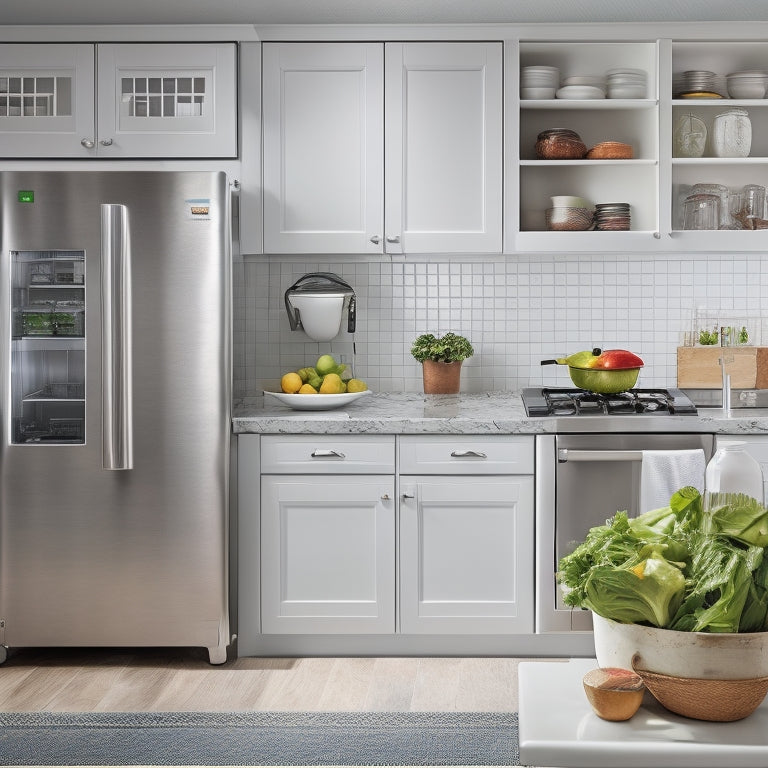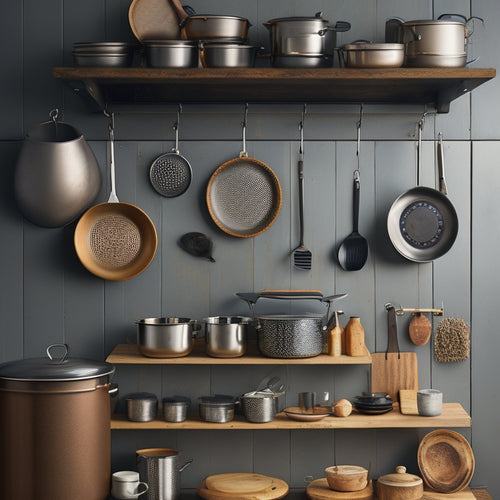
Mastering Food Safety in Home Kitchens
Share
Mastering food safety in home kitchens requires a thorough understanding of essential practices and protocols that prevent foodborne illnesses and contamination. Effective cleaning and sanitizing, impeccable personal hygiene, and proper allergen management are essential steps in maintaining a safe food environment. Safe food handling practices, including temperature control and proper storage, are also important. Moreover, implementing quality control measures and conducting regular checks can greatly reduce contamination risks. By grasping these fundamental principles, home cooks can guarantee a safer cooking space and prevent the spread of foodborne illnesses, discovering a wealth of knowledge to create a truly safe kitchen.
Key Takeaways
• Implement effective cleaning and sanitizing practices to prevent cross-contamination and foodborne illnesses in home kitchens.
• Maintain impeccable personal hygiene and good habits, such as washing hands frequently and wearing clean clothes, to prevent food contamination.
• Identify and manage allergens by accurately labeling ingredients, separating food preparation, and implementing risk management strategies.
• Practice proper food handling by controlling temperature, separating raw and ready-to-eat foods, and cooking to recommended internal temperatures.
• Establish a consistent sanitizing schedule and quality control measures, including product labeling and inventory control systems, to ensure food safety.
Cleaning and Sanitizing Essentials
Regularly incorporating effective cleaning and sanitizing practices into daily kitchen routines is essential for maintaining a safe and healthy food environment. Effective solutions, such as detergents and warm water, should be used in conjunction with proper techniques to clean all surfaces before sanitizing.
Chlorine sanitizing solutions, made with 1 tsp of unscented chlorine bleach per gallon of water, are a vital option. Sanitizing frequency is important, with high-touch areas requiring frequent sanitizing.
Store cleaning supplies separately and maintain a schedule for sanitizing to guarantee consistency. Proper storage tips, such as storing chlorine solutions in a cool, dark place, can help extend their shelf life.
Personal Hygiene and Habits
Maintaining impeccable personal hygiene and adopting good habits are essential elements in preventing the contamination of food and guaranteeing a safe kitchen environment. This includes adhering to proper handwashing techniques, wearing proper attire, and practicing hygienic habits.
To guarantee a safe kitchen environment, follow these essential habits:
-
Wear clean clothes, hair restraints, and remove nail polish and jewelry.
-
Cover cuts, wear gloves, and wash hands properly to prevent cross-contamination.
-
Avoid food preparation during illness, with pets, smoking, or children present.
- Make sure all helpers follow these guidelines to maintain a safe kitchen environment.
Managing Allergens and Risks
An important aspect of food safety in home kitchens is identifying and managing allergens, which can have severe consequences if not handled properly. Major allergens include milk, eggs, peanuts, and others, and it is essential to label them accurately and state their presence.
To prevent cross-contact, sequence food preparation, and thoroughly clean equipment between products. Implementing risk management strategies, such as allergen control measures, can greatly reduce the risk of contamination.
Effective allergen management requires attention to detail, clear labeling, and strict adherence to proper handling and storage procedures. By prioritizing allergen safety, home kitchens can minimize the risk of allergic reactions and establish a safe food environment for consumers.
Storage and Quality Control
In addition to managing allergens, home kitchens must also prioritize proper storage and quality control measures to guarantee the safety and integrity of prepared foods. This involves implementing effective product labeling and inventory control systems to make certain that products are stored and rotated correctly.
Use clear and descriptive labeling on all stored products, including ingredients, preparation dates, and storage instructions.
Implement a 'first-in, first-out' inventory control system to prevent older products from being stored for too long.
Conduct regular quality assurance checks to verify that products meet safety and quality standards.
Monitor and control shelf life by regularly checking expiration dates and removing expired products.
Safe Food Handling Practices
What constitutes safe food handling practices, and how can home kitchens guarantee that they are adopting these habits to prevent foodborne illnesses and contamination? Proper handling is vital to prevent cross contamination, which can lead to foodborne illness.
Temperature control is essential, as bacteria grow rapidly between 40°F and 140°F. Home kitchens should implement safe practices such as separating raw meat, poultry, and seafood from ready-to-eat foods, washing hands frequently, and using clean utensils and cutting boards. Additionally, cooking food to the recommended internal temperature and refrigerating perishable items promptly can prevent foodborne illness.
Frequently Asked Questions
Can I Use a Dishwasher to Sanitize Utensils and Equipment?
When sanitizing utensils and equipment, using a dishwasher with a sanitizing cycle and heat setting of at least 180°F (82°C) is effective, but make sure the dishwasher is properly maintained and operated to achieve peak sanitation.
How Often Should I Replace My Cleaning and Sanitizing Solutions?
As the clock ticks, sanitizing solutions silently surrender to chemical degradation, losing potency with each passing day. Mark the calendar, for solution expiration is a critical deadline, ensuring efficacy and food safety; replace solutions daily, or as specified, to maintain a fortress against contamination.
Are Homemade Cleaning Solutions Effective for Food Safety?
When it comes to cleaning solutions, natural alternatives and DIY recipes can be effective, but caution is recommended; verify that formulations are scientifically-backed, and ingredients are food-grade to avoid compromising food safety and potentially introducing new hazards.
Can I Reuse Cleaning Cloths and Sanitizing Wipes?
Reusing cleaning cloths and sanitizing wipes may seem convenient, but it risks cross-contamination and compromises cloth quality, potentially spreading harmful bacteria and undermining sanitizing efforts; instead, use fresh, high-quality cloths and dispose of wipes after a single use.
Do I Need to Sanitize My Kitchen Trash Cans Regularly?
Regular sanitizing of kitchen trash cans is essential for Odor Control and Pest Prevention, as accumulated waste can attract pests and create unpleasant smells, potentially contaminating food and surfaces.
Related Posts
-

7 Essential Tips for Pot and Pan Storage
You're tired of digging through a cluttered kitchen for the right pot or pan, and frustrated with the scratches and d...
